The current public image of the courthouse is evolving from an imposing, awe-inspiring, and even intimidating symbol to one that is welcoming and user-friendly. I recently wrote about concepts that can be applied to the exterior of a courthouse to make it more welcoming. In my view, a welcoming lobby is an extension of a welcoming exterior. The main entrance lobby is the first interior courthouse space encountered by the public. This article explores some of the techniques used to create a user-friendly courthouse lobby that will likely enhance the visitor’s entire judicial experience during the court planning process.
Competing Objectives
The public entrance lobby is defined by competing objectives. The space must:
- Provide security screening. This must be enforced without compromise.
- Welcome visitors to the building. As such, the overall feel should be light, bright, and inherently welcoming.
- Orient visitors to the layout of the building. Thus, adequate signage should be present.
As you can imagine, these aesthetic, practical, and life-safety objectives can be difficult to achieve without sacrificing one objective for another. Still, there are solutions for maintaining security without intimidating the visitor, or for providing signage that doesn’t compromise security. Let’s begin our exploration of the courthouse entrance lobby with a look at security.
Security
Last year, I was standing in a short security queue at the screening station of an Oklahoma courthouse. As I waited, I experienced first-hand the importance of thorough security practices. After processing a visitor’s backpack through the x-ray machine, one of the law enforcement officers opened the backpack and pulled out a can of Mace chemical spray. The visitor became belligerent but was immediately removed by law enforcement personnel.
I never discovered why the can of Mace was in the backpack, but I can only assume that its removal avoided a less-than-desirable experience in the courthouse that day. This experience reinforced my understanding that security at the courthouse entrance is critical!
Let’s consider the five basic components of security screening in a courthouse lobby:
- A building entrance and security screening station area with clear lines of sight for law enforcement staff who are stationed in the lobby and in the central security monitoring center
- A tightly controlled path for visitors to be channeled through security screening
- A place for law enforcement staff to check IDs
- A magnetometer to screen for restricted objects
- An x-ray machine to screen briefcases, backpacks, etc. for restricted objects (including Mace!)
These courthouse security features are all relatively easy to incorporate into an entrance lobby. But how to make them appear user-friendly?
Consider the security screening stations in the following two photos. I have personally entered these two courthouses and I can attest to the fact that both meet the five performance criteria cited above.
However, the first photo depicts security screening that appears somewhat harsh and not especially welcoming. (It was, in fact, both harsh and unwelcoming.) By contrast, the second security screening station appears considerably more welcoming. Why?

Intimidating Lobby Security
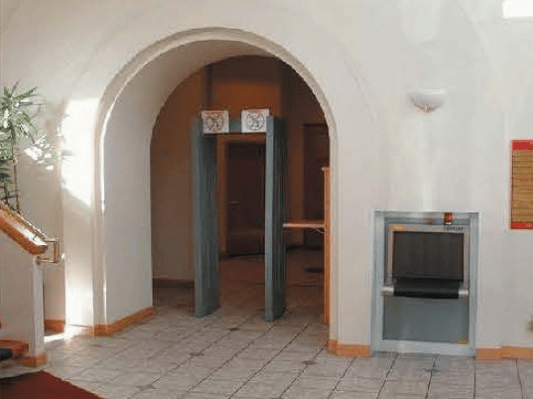
User-friendly Lobby Security
In the first photo, the x-ray machine and the magnetometer are highly prominent and the architecture is somewhat hard-edged. In the second photo, the equipment is incorporated into the architecture to make it seem less obtrusive. Plus, the design incorporates a welcoming arch. Both provide adequate security. But the second does so with the public experience in mind. Law enforcement personnel must present a welcoming demeanor, while still achieving absolutely air-tight security.
Architectural Image
As described in a recent article on user-friendly design, another feature that makes lobbies more aesthetically appealing is a design that extends two or more floors. Consider the small entrance lobby pictured below. When crowded with visitors, this lobby produces a distinct sense of claustrophobia.
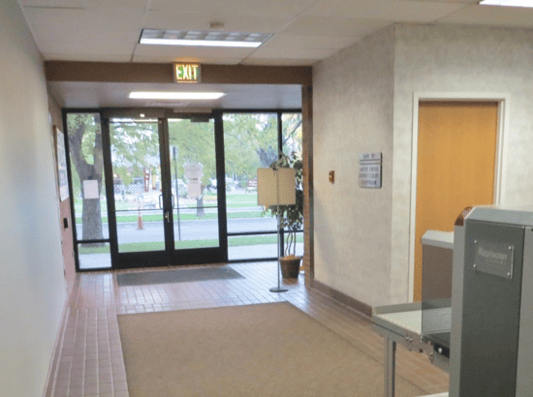
Claustrophobic Entrance Lobby
Contrast that claustrophobic space with the two-story entrance lobby shown below. When combined with multi-level windows, the taller space can be flooded with natural light to create a light, bright, and inherently welcoming space.
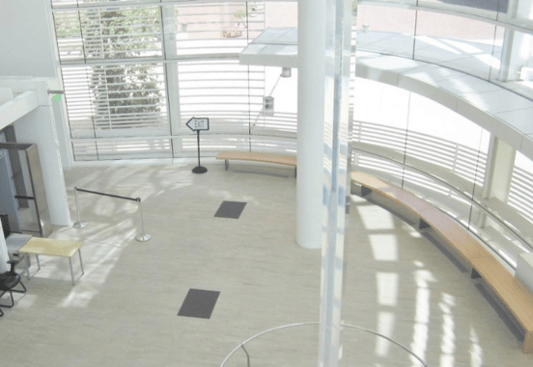
Light-filled Entrance Lobby
The addition of large scale artwork can further enhance the welcoming image.
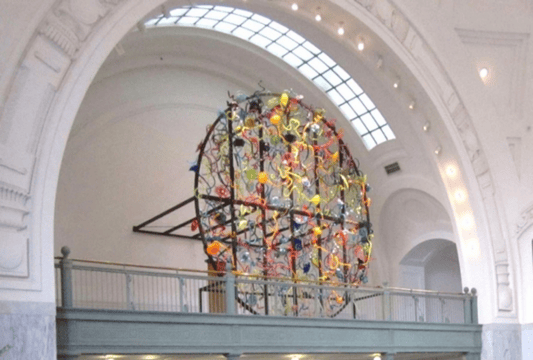
Entrance Lobby Artwork
Directional Clarity
Clear and prominent signage is vital in a courthouse entrance. Contrast the potentially confusing hodge-podge of multiple signs depicted in the following photo with the single interactive touch-screen in the second photo.

Hodge-podge of Signage
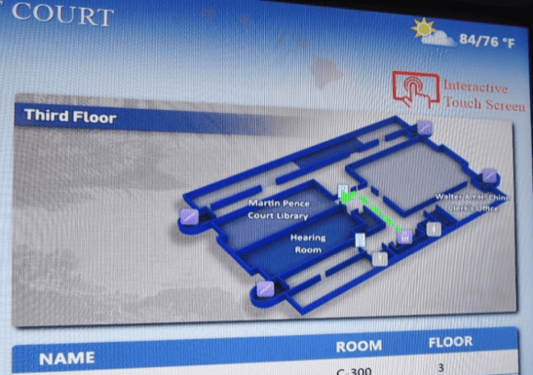
Interactive Signage
Providing a light, bright courthouse entrance that acts as a focal point can also help the visitor better comprehend the organization of the building. Being able to see portions of the upper floors from a multi-story entrance lobby, as is evident in the following photo, can allow the visitor to gain a sense of his or her whereabouts and destination in the courthouse. A set of stairs or an escalator from the entrance lobby to the second floor can also add a welcoming visual progression.

Entrance Lobby Stairs
The more common practice of immediately directing visitors into an elevator off the lobby, as depicted below, does not allow for this visual orientation experience. Upon exiting the elevator on the upper floors, visitors must rely on signage for orientation. A multi-story open entrance lobby that provides visual orientation combined with stairs and elevators is usually the optimal solution.

Entrance Lobby Elevators
Making a Difference
It’s a completely different experience to proceed through a lobby and security screening area that take the visitor’s perspective into account. Open space and visibility for security officers make the building look and feel safer. Local artwork goes a long way in reflecting a community’s spirit and culture. Large windows with natural light and views of the surrounding buildings provide warmth and context. Clear signage helps ease the visitor’s anxiety and provides a welcoming introduction to the building. It is amazing the difference a user-friendly lobby can make.




.jpg)
.jpg)
.jpg)
.jpg)
.jpg)
-1.jpg)
.jpg)
.jpg)

